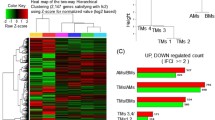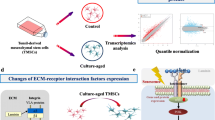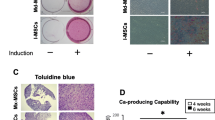Abstract
Background:
Mesenchymal stem cells (MSCs) are widely used in regenerative medicine and cell-based transplantations. However, an in-depth comparison of the different MSC origins is lacking. This study aimed to compare the expression of adipose-derived (AMSCs), bone marrow-derived (BMSCs), and tonsil-derived (TMSCs) and evaluate whether TMSCs are good alternatives for AMSCs or BMSCs.
Methods:
We analyzed the expression levels of 47,000 transcripts in AMSCs (n = 4), BMSCs (n = 4), and TMSCs (n = 4) using GeneChip. Microarray data were analyzed using the LIMMA package to compare the TMSCs, AMSCs, and BMSCs. Hub genes were analyzed using STRING and Cytoscape. To ascertain the functional roles of AURKA and AURKB, small interfering RNA (siRNA) molecules specifically targeting AURKA and AURKB mRNA were synthesized and employed to induce knockdown of AURKA and AURKB in TMSC and AMSC. We analyzed the expression level of OCT4, SOX-2, and NANOG genes in TMSC and AMSCs by cell culture and real-time PCR.
Results:
We identified commonly increased 256 and decreased 160 genes in TMSCs from the differentially expressed genes (DEGs) between the TMSCs, AMSCs, and BMSCs. In the DEG-based protein–protein interaction and gene set enrichment analysis, hub genes (AURKA, AURKB, CDC20, and BUB1) highly expressed in TMSCs were enriched for development- and progression-related oocyte meiosis, the cell cycle, and ubiquitin-mediated proteolysis. In vitro analysis demonstrated that cells with downregulated expression of AURKA and AURKB exhibited a significant reduction in proliferation compared to control cells. However, silencing of the genes did not affect the differentiation capacity in TMSCs and AMSCs.
Conclusion:
Our study compared MSCs of different origins to better understand the similarities and differences among these cell types.








Similar content being viewed by others
Data availability
Microarray used in this study are available in the Gene Expression Omnibus (GEO) at https://www.ncbi.nlm.nih.gov/geo/, and can be accessed with GSE77272 (accession number).
References
Zakrzewski W, Dobrzyński M, Szymonowicz M, Rybak Z. Stem cells: past, present, and future. Stem Cell Res Ther. 2019;10:68.
Nadig RR. Stem cell therapy—Hype or hope? A review. J Conserv Dent JCD. 2009;12:131–8.
Hoang DM, Pham PT, Bach TQ, Ngo ATL, Nguyen QT, Phan TTK, et al. Stem cell-based therapy for human diseases. Signal Transduct Target Ther. 2022;7:272.
Beliën H, Evens L, Hendrikx M, Bito V, Bronckaers A. Combining stem cells in myocardial infarction: the road to superior repair? Med Res Rev. 2022;42:343–73.
Gao L, Xu W, Li T, Chen J, Shao A, Yan F. Stem cell therapy: a promising therapeutic method for intracerebral hemorrhage. Cell Transplant. 2018;27:1809–24.
Daley GQ. Stem cells and the evolving notion of cellular identity. Philos Trans R Soc Lond B Biol Sci. 2015;370:20140376.
Ding DC, Shyu WC, Lin SZ. Mesenchymal stem cells. Cell Transplant. 2011;20:5–14.
Friedenstein AJ, Chailakhyan RK, Gerasimov UV. Bone marrow osteogenic stem cells: in vitro cultivation and transplantation in diffusion chambers. Cell Tissue Kinet. 1987;20:263–72
Mushahary D, Spittler A, Kasper C, Weber V, Charwat V. Isolation, cultivation, and characterization of human mesenchymal stem cells. Cytometry A. 2018;93:19–31.
Halvorsen YC, Wilkison WO, Gimble JM. Adipose-derived stromal cells—their utility and potential in bone formation. Int J Obes Relat Metabol Disord: J Int Assoc Stud Obes. 2000;24:S41–4.
Pittenger MF, Mackay AM,Beck SC, Jaiswal RK, Douglas R, Mosca JD, et al. Multilineage potential of adult human mesenchymal stem cells. Science (New York, NY). 1999;284:143–7.
Trounson A, Thakar RG, Lomax G, Gibbons D. Clinical trials for stem cell therapies. BMC Med. 2011;9:52.
Bačić A, Prgomet D, Janjanin S. Tonsil-derived mesenchymal stem cells exert immunosuppressive effects on T cells. Croat Med J. 2019;60:12–9.
Ryu KH, Cho KA, Park HS, Kim JY, Woo SY, Jo I, et al. Tonsil-derived mesenchymal stromal cells: evaluation of biologic, immunologic and genetic factors for successful banking. Cytotherapy. 2012;14.
Jessen KR, Mirsky R. Negative regulation of myelination: relevance for development, injury, and demyelinating disease. Glia. 2008;56:1552–65.
Kim JM, Kim JH, Kim K, Shin SC, Cheon YI, Kim HS, et al. Tonsil mesenchymal stem cells-derived extracellular vesicles prevent submandibular gland dysfunction in ovariectomized rats. Aging (Albany NY). 2022;14:2194–209.
Kim HY, Oh SY, Choi YM, Park JH, Kim HS, Jo I. Transient receptor potential vanilloid 2 mediates the inhibitory effect of far-infrared irradiation on adipogenic differentiation of tonsil-derived mesenchymal stem cells. Stem Cell Res. 2021;53:102291.
Oh SY, Choi YM, Kim HY, Park YS, Jung SC, Park JW, et al. Application of Tonsil-Derived Mesenchymal Stem Cells in Tissue Regeneration: Concise Review. Stem Cells. 2019;37:1252–60.
Lee BJ, Kang DW, Park HY, Song JS, Kim JM, Jang JY. Isolation and localization of mesenchymal stem cells in human palatine tonsil by W5C5 (SUSD2). Cell Phys Biochem. 2016;38:83–93
Shin SC, Seo Y, Park HY, Jung DW, Shin TH, Son H, et al. Regenerative potential of tonsil mesenchymal stem cells on surgical cutaneous defect. Cell Death Dis. 2018;9:183
Seo Y, Shin TH, Ahn JS, Oh SJ, Shin YY, Yang JW, et al. Human tonsil-derived mesenchymal stromal cells maintain proliferating and ROS-regulatory properties via stanniocalcin-1. Cells. 2020;9:636.
Seo Y, Shin TH, Ahn JS, Oh SJ, Shin YY, Yang JW, et al. Tensin-3 regulates integrin-mediated proliferation and differentiation of tonsil-derived mesenchymal stem cells. Cells. 2019;9:89.
Park GC, Song JS, Park HY, Shin SC, Jang JY, Lee JC, et al. Role of fibroblast growth factor-5 on the proliferation of human tonsil-derived mesenchymal stem cells. Stem Cells Develop. 2016;25:1149–60.
Kim Y, Kim H, Cho H, Bae Y, Suh K, Jung J. Direct comparison of human mesenchymal stem cells derived from adipose tissues and bone marrow in mediating neovascularization in response to vascular ischemia. Cell Physiol Biochem. 2007;20:867–76.
Lee RH, Kim BC, Choi I, Kim H, Choi HS, Suh K, et al. Characterization and expression analysis of mesenchymal stem cells from human bone marrow and adipose tissue. Cell Physiol Biochem. 2004;14:311–24.
Ritchie ME, Phipson B, Wu D, Hu Y, Law CW, Shi W, et al. limma powers differential expression analyses for RNA-sequencing and microarray studies. Nucleic Acid Res. 2015;43:e47.
Szklarczyk D, Gable AL, Nastou KC, Lyon D, Kirsch R, Sampo Pyysalo S, et al. The STRING database in 2021: customizable protein-protein networks, and functional characterization of user-uploaded gene/measurement sets. Nucleic Acids Res. 2021;49:D605–12.
Shannon P, Markiel A, Ozier O, Baliga NS, Wang JT, Ramage D, et al. Cytoscape: a software environment for integrated models of biomolecular interaction networks. Genome Res. 2003;13:2498–504.
Bader GD, Hogue CW. An automated method for finding molecular complexes in large protein interaction networks. BMC Bioinformatics. 2003;4:2.
Chin CH, Chen SH, Wu HH, Ho CW, Ko MT, Lin CY. cytoHubba: identifying hub objects and sub-networks from complex interactome. BMC Syst Biol. 2014;8:S11.
Ashburner M, Ball CA, Blake JA, Botstein D, Butler H, Cherry JM, et al. Gene ontology: tool for the unification of biology. The Gene Ontology Consortium. Nat Genet. 2000;25:25–9.
Kanehisa M, Furumichi M, Tanabe M, Sato Y, Morishima K KEGG: new perspectives on genomes, pathways, diseases and drugs. Nucleic Acids Res. 2017;45:D353–61.
Kuleshov MV, Jones MR, Rouillard AD, Fernandez NF, Duan Q, Wang Z, et al. Enrichr: a comprehensive gene set enrichment analysis web server 2016 update. Nucleic Acids Res. 2016;44:W90-7.
Weinstein J, Jacobsen FW, Hsu-Chen J, Wu T, Baum LG. A novel mammalian protein, p55CDC, present in dividing cells is associated with protein kinase activity and has homology to the Saccharomyces cerevisiae cell division cycle proteins Cdc20 and Cdc4. Mol Cell Biol. 1994;14:3350–63.
Du Y, Zhang M, Liu X, Li Z, Hu M, Tian Y, et al. CDC20 promotes bone formation via APC/C dependent ubiquitination and degradation of p65. EMBO Rep. 2021;22:e52576.
Han JY, Han YK, Park GY, Kim SD, Lee CG. Bub1 is required for maintaining cancer stem cells in breast cancer cell lines. Sci Rep. 2015;5:15993.
Bruno S, Ghelli Luserna di Rorà A, Napolitano R, Soverini S, Martinelli G, Simonetti G. CDC20 in and out of mitosis: a prognostic factor and therapeutic target in hematological malignancies. J Exp Clin Cancer Res CR. 2022;41:159.
Sun Q, Zhao H, Zhang C, Hu T, Wu J, Lin X, et al. Gene co-expression network reveals shared modules predictive of stage and grade in serous ovarian cancers. Oncotarget. 2017;8:42983–96.
Ji P, Smith SM, Wang Y, Jiang R, Song SW, Li B, et al. Inhibition of gliomagenesis and attenuation of mitotic transition by MIIP. Oncogene. 2010;29:3501–8.
Kwan PS, Lau CC, Chiu YT, Man C, Liu J, Tang KD, et al. Daxx regulates mitotic progression and prostate cancer predisposition. Carcinogenesis. 2013;34:750–9.
Zhou X, Yuan Y, Kuang H, Tang B, Zhang H, Zhang M. BUB1B (BUB1 Mitotic Checkpoint Serine/Threonine Kinase B) promotes lung adenocarcinoma by interacting with Zinc Finger Protein ZNF143 and regulating glycolysis. Bioengineered. 2022;13:2471–85.
Singh AM, Chappell J, Trost R, Lin L, Wang T, Tang J, et al. Cell-cycle control of developmentally regulated transcription factors accounts for heterogeneity in human pluripotent cells. Stem Cell Rep. 2013;1:532–44.
Knoblich JA. Mechanisms of asymmetric stem cell division. Cell. 2008;132:583–97.
Goldenson B, Crispino JD. The aurora kinases in cell cycle and leukemia. Oncogene. 2015;34:537–45.
Yin Y, Chen F, Li J, Yang J, Li Q, Jin P. AURKA enhances autophagy of adipose derived stem cells to promote diabetic wound repair via targeting FOXO3a. J Invest Dermatol. 2020;140:1639–49.
Rosenthal CK. Aurora A maintains embryonic stem cells. Nat Cell Biol. 2012;14:990.
Dar AA, Belkhiri A, Ecsedy J, Zaika A, El-Rifai W. Aurora kinase A inhibition leads to p73-dependent apoptosis in p53-deficient cancer cells. Cancer Res. 2008;68:8998–9004.
Shaalan AK, Teshima THN, Tucker AS, Proctor GB. Inhibition of aurora kinase B activity disrupts development and differentiation of salivary glands. Cell Death Discov. 2021;7:16.
Acknowledgment
This study was supported by the Basic Research Program (No. 2021R1A6A3A01086785, 2022R1A2C2006697) of the National Research Foundation of Korea. This study was also supported in part by the Korea Health Technology R&D Project through the Korea Health Industry Development Institute (KHIDI), which is funded by the Ministry of Health & Welfare, Republic of Korea (No. HI22C1377).
Author information
Authors and Affiliations
Contributions
Sohee Park and Yeuni Yu contributed the manuscript writing, collection and/or assembly of data, data analysis and interpretation. Gi Cheol Park and Sung-Chan Shin contributed to the quality assessment of the study. Ji Min Kim and Byung-Joo Lee contributed to the designed the experiments. Yun Hak Kim and Byung-Joo Lee contributed to the study conception. Sohee Park, Yeuni Yu, Ji Min Kim, Byung-Joo Lee and Yun Hak Kim wrote the manuscript. All authors critically reviewed the manuscript and approved the final draft.
Corresponding authors
Ethics declarations
Conflicts of interest
The authors declare no competing interests.
Ethical Statement
This study was approved by the Institutional Review Board of Pusan National University Hospital (IRB No. 1801-033-062). Informed consent was confirmed by the IRB.
Additional information
Publisher's Note
Springer Nature remains neutral with regard to jurisdictional claims in published maps and institutional affiliations.
Rights and permissions
Springer Nature or its licensor (e.g. a society or other partner) holds exclusive rights to this article under a publishing agreement with the author(s) or other rightsholder(s); author self-archiving of the accepted manuscript version of this article is solely governed by the terms of such publishing agreement and applicable law.
About this article
Cite this article
Park, S., Yu, Y., Park, G.C. et al. Proliferation-Related Features of the Human Mesenchymal Stem Cells Derived from Palatine Tonsils, Adipose Tissues, and Bone Marrow. Tissue Eng Regen Med 20, 1119–1132 (2023). https://doi.org/10.1007/s13770-023-00564-7
Received:
Revised:
Accepted:
Published:
Issue Date:
DOI: https://doi.org/10.1007/s13770-023-00564-7




